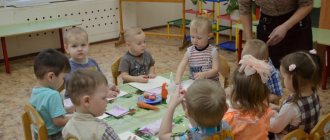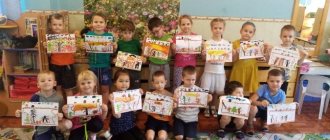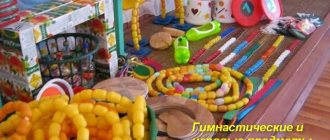Secrets of successful classes with preschoolers
Children 5-6 years old can perform well in homework. Adults must provide favorable conditions for this, for example:
- an exciting start with strong motivation (what we will do and why; we will learn..., we will find out...; we will play...);
- brevity in setting tasks (gradually you need to ensure that the child retains in memory the instructions of at least 3 points);
- accuracy of explanation of the task in accessible language (to perform it correctly, you need to clearly understand what to do);
- inclusion of outdoor games and exercises as physical education minutes between complex tasks and as a separate block at the end of the lesson;
- summing up at the end of the “lesson” (what was learned, what was liked; reward for special achievements); the ending can be in the form of a funny poem that parents recite with their child at the end of each lesson.
Cooking is also included in the list of developmental activities.
Parents should be very careful when studying at home. You need to listen to what the child says, think about your words, patiently wait for the task to be completed and invite the “student” to explain his actions. This forms self-control, activates attention and memory. Such qualities will be useful when entering 1st grade.
Schedule
Kindergartens can have a variety of directions: speech therapy, health, private and public, specialized for children with disabilities. But they all have one thing in common: their daily routine. Everywhere it is approximately the same and is designed taking into account all the needs of pupils of different age groups.
You can check it out right now on the website supermams.ru.
So, here's what children do in kindergarten:
- From 6:00 to 8:00 – reception of children: they change into comfortable change of clothes and shoes, do exercises. Medical staff examines the group for sick children.
- From 8:00 to 8:30 – breakfast.
- From 8:30 to 10:00 – study in circles.
- From 10:00 to 10:30 – preparation for the walk: children change clothes.
- From 10:30 to 11:45 – walk in the fresh air.
- From 11:45 to 12:00 – children return from the street and change clothes and wash their hands.
- From 12:00 to 12:30 – lunch.
- From 12:30 to 15:00 – quiet time.
- From 15:00 to 15:30 – children get dressed and get ready for dinner.
- From 15:30 to 16:00 – dinner.
- From 16:00 to 18:00 – games together with preparations for home.
To avoid any questions, it should be noted that in any specialized kindergartens additional classes are introduced into the daily routine. For example, in speech therapy - to eliminate speech defects, for children with hearing or vision problems - aimed at restoring hearing and visual acuity.
Development guidelines at 5-6 years old
Developmental activities without a specific goal will not bring success. You need to know what to teach children. For example, at the age of 5 years, a child can cope with the following tasks:
- tell about yourself and your family;
- name the time of year, time of day;
- explain the simplest cause-and-effect relationships (mom does the laundry because...; dad took the umbrella because...);
- explain the purpose of household items (why do you need a table, chair, pan, pen);
- name geometric figures and objects similar in shape to them;
- count several objects going through ten;
- name the colors;
- tell what parts furniture and household items consist of;
- remember and pronounce words and phrases in a foreign language;
- shade the outline drawing; cut strips of paper with scissors and make a rug out of them; copy the pattern.
At 5 years old, children can explain their thoughts, know colors, and can count.
At 6 years old, children can do more complex actions:
- understanding the plot connection of pictures and composing a story;
- explanation of the meaning of simple proverbs;
- performing basic arithmetic operations;
- generalization and division into groups;
- explanation of the meaning of the word (actions, signs, concrete objects and abstract concepts);
- drawing up the rules of the game;
- orientation in space and time;
- drawing a person, copying patterns and geometric shapes;
- performing game exercises, repetition and composing simple dialogues in English.
Skills at 6 years old depend on the amount of homework and kindergarten attendance
Special home study opportunities
Educational activities with your child at home have many advantages.
A flexible schedule allows you to take into account children’s temperament, speed of perception and thinking, and character traits. During classes at home, various “rituals” (poems, songs, special words, fun warm-ups) are easily invented and performed, setting the child up to start or complete work.
Home classes are very convenient
At home, you always have the necessary supplies at hand. During the lesson you may need not only paper and pencils, but also construction sets, cubes, and toys for role-playing games.
Even furniture is quickly turning into a piece of educational equipment. And if a child is learning English, then during the lesson the necessary cards with letters and words are quickly prepared. This will help parents teach their child to read English and prepare them to master written language.
Useful tips for teaching kids to read English texts
Children under 6 years of age develop unusually quickly. This is facilitated by flexible memory, developing attention and strengthening thinking. Very important qualities for learning to read in English!
English lessons at home will help your child adapt to school faster
It is important to know: at 3 years old, a child’s visual-figurative thinking predominates; From 5 to 6 years old, the abstract-logical begins to form.
Therefore, when teaching children a foreign language, you can safely use phonetic, graphic and verbal methods.
Children aged 5-6 years easily perceive words and phrases in English by ear, remember and reproduce them. Older preschoolers are able to compare oral explanations, the sound of English words and phrases and their graphic form.




